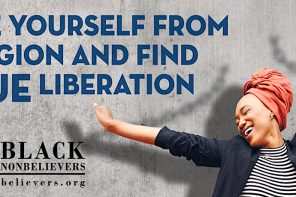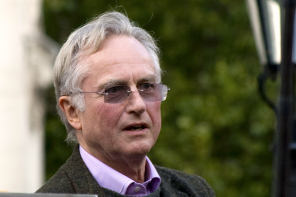Faitheist is the winsome story of a working-class white kid growing up amidst fragments of other people’s religions, who as a teenager latches onto the energy of evangelical Christianity, then comes to terms with his sexuality, leaves Christianity for atheism, and goes to theology school where he joins the movement for interfaith justice… as an atheist. It is the story of Christopher Stedman, who at 25 years old is now assistant humanist chaplain at Harvard University and a surprising and influential new voice in the interfaith justice movement and American atheism. Stedman models an atheism that while uncompromising in its principles is also warm towards and respectful of religious believers—a striking shift from the hard-hitting argumentation of the New Atheist movement—and ends up humanizing atheism while he’s at it.
New Atheists—Richard Dawkins, Christopher Hitchens, Sam Harris, and so on—have been all about the polemic. But you chose to write in a very different genre: memoir. Why?
Interfaith work gives a central place to the idea of exchanging stories to create more understanding and enrich the quality of the conversations that take place between people in various communities. As I began to speak about and do work related to the intersection of atheist identity and interfaith dialogue, I drew a lot on my personal stories and began to recognize how my experiences shaped my conclusions and my work. I stepped back and observed the narrative arc of my own life. I think narrative is a very helpful entry point to a more constructive and compassionate discourse, and so I wanted to model that by moving away from talking about these issues in a theoretical way and grounding them in real-world experiences.
What’s been the reaction to your work?
When the book first came out, there were some early negative responses—from atheists in particular. As time has gone on, I have been able to see my book and the response to it as part of thriving and ultimately heartening conversations both within the atheist community and between atheists and religious communities. Of course, there are still a number of people who are, if not entirely resistant to the ideas in the book, at least deeply suspicious about or don’t see much value in them.
One thing I find valuable about Faitheist is that it moves atheism away from the kind of polemic that ends up focusing on truth claims in a very literal way and so mirrors the religious fundamentalisms it would like to dismantle. A few months ago, when we were together at an interfaith conference, I posed to you the question of whether American atheism as a movement could further dislodge itself from a polemic truth claims approach by historicizing itself and narrating its own emergence as a movement. Perhaps your memoir is a step in that direction.
When I was coming out as queer, what really made it possible for me to identify myself within a queer narrative was the fact that there were a number of different narratives available to me. Identifying as an atheist, I went through a similar process, but there weren’t the same range of narratives. And I kept meeting other atheists who felt the same way I did—who felt like their identities and their stories weren’t represented in the most dominant atheist narratives.
How would you characterize narrative American atheism has told about itself? If we actually asked atheists to historicize themselves as a movement, to tell a collective story, what would that sound like?
Though there is a fascinating history of American atheism, it’s hard to answer that question right now. We’re a small and frequently demonized community, and there has not been a lot of fluidity in the way we’ve talked about atheism. Instead, the narrative of what it means to be an atheist has been put in very strong contrast or opposition to religious narratives. As if there are fixed and impenetrable boundaries between the two.
And the greatest energy—again, looking at the example of the New Atheists—seems to go to the strongly oppositional or even antagonistic stories.
There seem to be a lot of stipulations put into those atheist narratives. Some would make it so that you have to be completely on board with point X, Y, and Z in order to even count as an atheist. As a former fundamentalist Christian, I understand that impulse, but I am surprised by how pervasive it is within organized atheism.
I read about a recent study of Finnish atheists and religionists in the International Journal for the Psychology of Religion that found that the concept of God had as powerful an emotional force for atheists as it did for believers. So functionally, despite the abstract and conceptual rejection of God, it would seem that that the God-concept is still functionally alive for atheists.
Perhaps. I think that may be the case for many atheists who rank their atheist identity high on the list of ways in which they’d describe themselves. But I suspect that the silent majority of non-theists, who could perhaps be described as “apatheists”—people not engaged in the atheist movement, who are largely apathetic about whether or not a god exists—might have a different disposition.
Carl Sagan emerges as an inspirational figure in your writings. You even have a tattoo of a wonderful Sagan quote: “For small creatures such as we the vastness is bearable only through love.”
Carl Sagan is someone whose general approach I really admire and have tried to emulate as best as I can. He was an agnostic but that wasn’t at the forefront of his work—he was first and foremost a science communicator. The way he went about doing his work was compassionate and understanding towards people who didn’t agree with his ideas. He invited people into considering the questions he was posing rather than forcefully pushing his conclusions onto them.
Inviting people in takes a lot of vulnerability, especially for atheists who are so often the object of vilification in American society. The surveys, for example, routinely show that Americans are less likely to vote for an atheist for president than an individual of any other social, religious, or ethnic group. This vilification has really shaped the aggressively defensive public posture some atheists seem to assume. But I read your work and find myself imagining what an atheist ethic of hospitality might look like.
Or neighborliness.
Yes. Neighborliness and hospitality are crucial components or concepts in Judeo-Christian religiosity, but they’re also humanist moral concepts. What is shifting that may be allowing a new, less defensive presentation of atheism to emerge?
The atheist community still exists on the margins even in conversations about faith and values. The spaces where we are not either demonized or rendered invisible are very liminal. What’s shifting is that as more and more attention is given to religiously unaffiliated populations, it has carved out a path for atheists. The data suggests that a significant majority of the religiously unaffiliated are not atheists, but the general public sometimes assumes they are. Increased attention to the unaffiliated is an opportunity for atheists to articulate ourselves and carve out a clearer identity.
The unaffiliated—or, the “nones” as they’re popularly called—really do shine a light on the fact that the socially compulsory quality of religion is waning for most of the population. What happens when one does not feel they must go to church or synagogue to be a good person? Then one can choose religion as an expression of desire, belonging, hope, beauty, love, or pleasure. You’ve certainly made a good case here that atheism can deliver those things.
Thank you! I tried to be careful to not say that my way is the best way forward for anyone—atheist or not. Whenever someone decides they have discovered the best way and that other people should walk the same path, it’s a real turn-off. Atheist polemicists have done a lot to raise the visibility of atheists, but they haven’t made atheism all that attractive for many people and part of the reason why that is—fairly or unfairly—is that they’ve been presented in the media as telling people what to do rather than inviting them to consider an alternative way forward. In the book, I was very mindful about saying, “This is how it has been for me. This is where I am right now.” I hope to invite people to think about their own lives, and I hope other people will step forward and offer their own stories so that we can build a larger canon of stories and ideas that demonstrate the value of having more open, challenging, compassionate, and patient conversations about religious differences.




